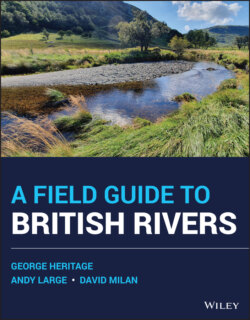Читать книгу A Field Guide to British Rivers - George Heritage - Страница 12
1.2 The Importance of River and Floodplains
ОглавлениеDynamic landscapes exhibit high spatial and temporal environmental heterogeneity and strong speciosity (Connell 1978) and naturally functioning fluvial systems represent some of the most dynamic landscapes on the planet. This is reflected in their very high conservation value (Ratcliffe 1977). They also display some of the highest biological productivity and ecosystem diversity on Earth (Tockner and Stanford 2002), principally due to their dynamic behaviour and their transitional nature as they form an ecotone, or transitional boundary, between terrestrial and aquatic environments. Mitsch and Gosselink (2000) estimated that, globally, floodplains cover approximately 1.4% of the planet’s land surface (0.8 × 106 km2 to 2 × 106 km2); however, they contribute around 25% of all terrestrial ecosystem services (Tockner and Stanford 2002). When the natural dynamics of river and floodplain systems are subdued or lost; however, the system becomes dysfunctional and the loss of dynamism results in environmental homogeneity and stasis. Diversity is reduced under such conditions with the landscape becoming dominated by a few key species best adapted to the imposed conditions (Stanford et al. 1996). Flood‐controlled disturbances, occurring as part of the natural flow regime, stimulate geomorphic processes and promote vegetative succession (Amoros and Roux 1988; Junk et al. 1989). As a result, natural floodplains display complex dynamic spatial vegetation mosaics controlled by the morphology and the associated surface and subsurface hydrological regime (Thoms 2003). The features and vegetation present are often also a reflection of both present and past geomorphological activity associated with the fluvial system (Nanson and Croke, 1992) with features developing ecologically as connectivity with the main river alters over time.
The preponderance of a near homogenous fluvial landscape, where natural processes are almost completely suppressed and continue to be suppressed through active management, offers little hope of any return to a more natural, dynamic, and diverse system unless current agricultural practices, not just on floodplains but also across the wider catchment, are fundamentally altered. Small‐scale restoration may partially restore some river and floodplain features and processes, but suppression elsewhere will mean that ecological gains remain highly localised and fundamentally unsustainable into the long term.
Longitudinal and lateral fragmentation of large river systems, linked principally to human activities, has also contributed to severe and widespread floodplain degradation, and this is fundamentally threatening the integrity of running water ecosystems (Dynesius and Nilsson 1994; Schiemer 1999). This degradation is closely linked to a rapid decline in freshwater biodiversity, principally due to habitat alteration through altered land use and flow patterns, flood control, pollution and to invasive species. Tockner and Stanford (2002) provide the stark statistic that in Europe and North America, up to 90% of floodplains are already “cultivated” and therefore functionally extinct.
